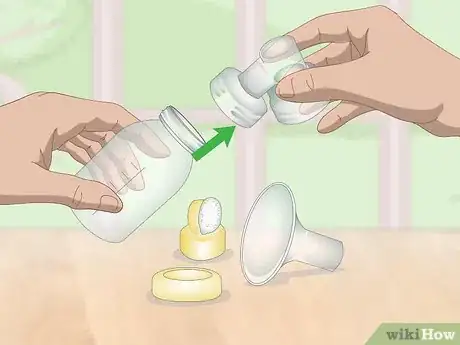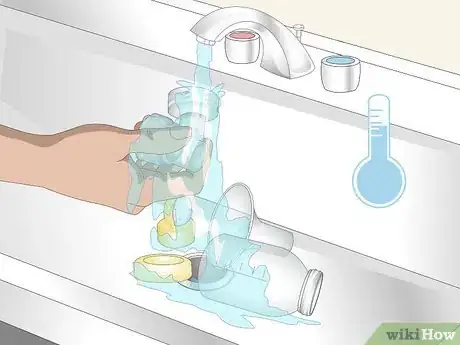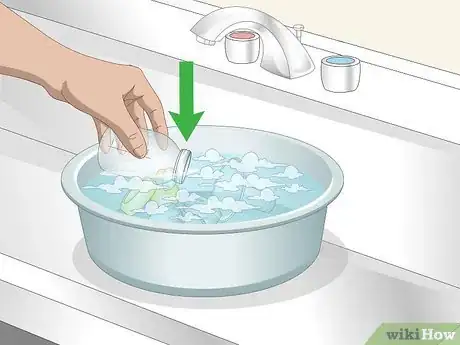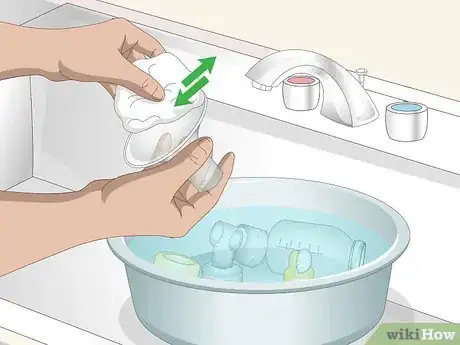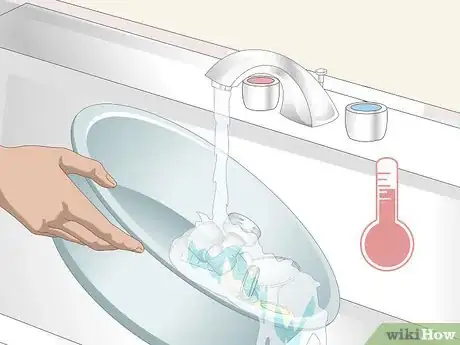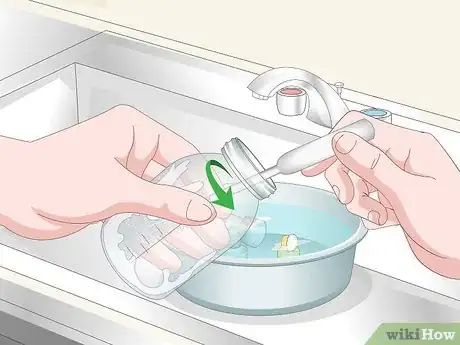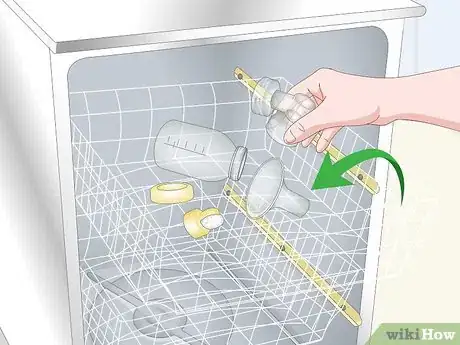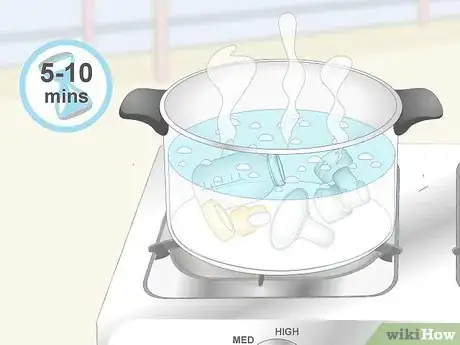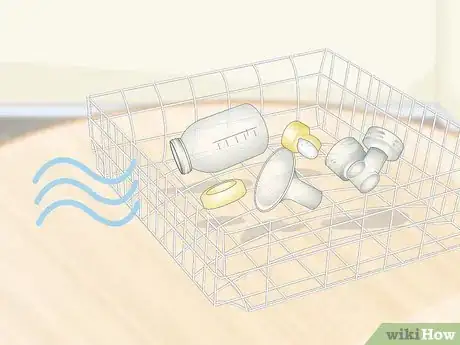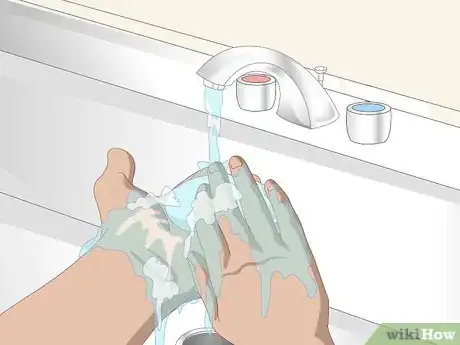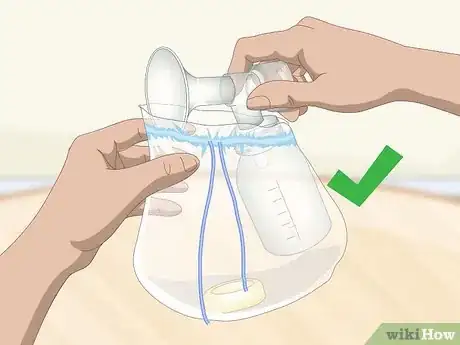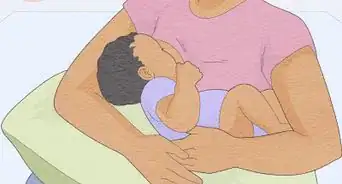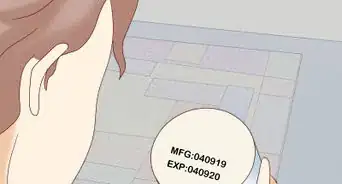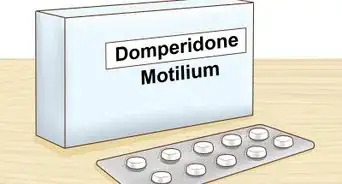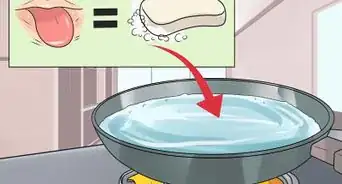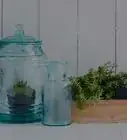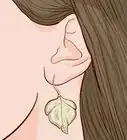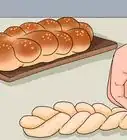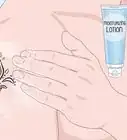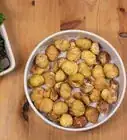This article was co-authored by Julie Matheney, MS, CCC-SLP, CLEC, IBCLC. Julie Matheney is an International board certified Lactation Consultant (IBCLC) and the Founder of The LA Lactation Lady, her lactation consulting business based in Los Angeles, California. She has over eight years of lactation consulting experience. She earned her MS in Speech-Language Pathology from Miami University and has earned a Certificate of Clinical Competence for Speech-Language Pathologists (CCC-SLP). She also earned her Certified Lactation Educator Counselor (CLEC) certificate from the University of California, San Diego.
This article has been viewed 14,236 times.
Medela breast pumps, like most breast pumps, help mothers keep their milk supply flowing and allow them to have milk readily available when their babies need to be fed. However, any milk residue left in the pump parts can cause bacteria to grow, exposing you and your baby to potential harmful effects. Protect you and your baby by hand-washing all the parts of the pump that come into contact with the milk every time you use them. Then, sanitize the washed pump parts daily in the dishwasher or in boiling water.
Steps
Washing After Use
-
1Take apart all the pieces that come into contact with breast milk. To disassemble, first separate the breast shields from the shield connectors Then, twist the yellow valves off of the connectors. Finally, remove the white membranes from the yellow valves.[1]
- There are several different pump models. Verify which parts should be cleaned in the instruction manual for the model you are using.
-
2Rinse each piece in cool water immediately after pumping. One at a time, hold the parts under running cool water to remove milk residue. Run the water over the pump parts until all visible traces of milk have been rinsed away. However, do not get water inside the pump tubes, as it can be difficult to get them completely dry.[2]Advertisement
-
3Submerge the parts in a basin filled with hot, soapy water. Add a few drops of dishwashing liquid to a clean basin filled with enough hot water to cover the parts. Then, submerge the parts into the basin.[3]
- The temperature of the water should be as warm as you can stand to put your hands in without burning yourself.
- Do not wash the parts in the kitchen sink because the germs in the sink or the drains from cooking or washing hands can contaminate the pump. Instead, use a plastic tub or basin that is only for cleaning your baby-feeding supplies.[4]
-
4Scrub each part individually using a clean rag or a baby bottle brush. Remove the items from the water one at a time and scrub away the surface bacteria and all remaining milk residue you may have missed. Be sure to wash the entire surface of the parts, using a bottle brush to get into the smaller crevices, and ports.[5]
-
5Use hot water to rinse off all of the soap residue. Run the parts under hot water for 10-15 seconds until you are sure you have washed all the soap. Then, place the parts on a clean paper towel or drying rack.[6]
- If you need to pump again, the parts are safe to reassemble as soon as they are dry.
- Avoid using cloth towels because they are more likely to carry germs and bacteria that can be transferred to the pump.[7]
Sanitizing Daily
-
1Wash the parts thoroughly before sanitization. Before you take the steps to sanitize the pump parts, you want to make sure all the milk residue is removed, as well as any surface germs or bacteria. Clean the pump as usual with hot, soapy water and rinse well.[8]
- Don't forget to clean and sanitize the cleaning brushes and basin as well.[9]
-
2Use your dishwasher for convenient sanitization. If your dishwasher has a hot water setting and a heat-drying or sanitizing option, you can use the dishwasher to sanitize the pump parts. Use a mesh bag or baby bottle dishwasher container that allows the free-flow of the water but keeps the parts from flying around inside. Place the parts in the container on the top rack and run as usual.[10]
- For maximum sanitizing effect, do not wash the pump parts in the dishwasher with your dirty dishes.
-
3Boil the pump parts for 5-10 minutes for effective sanitation. One of the most effective ways to kill off germs and bacteria is by submerging the parts in boiling water. Just bring enough water to cover the parts to a boil on the stovetop. Then, carefully place the parts in the water and allow them to boil for 5-10 minutes before removing them.[11]
- To avoid burning yourself, allow the water to cool before removing the parts and use clean tongs when handling them.[12]
Storing Sanitized Pumps
-
1Leave the pump parts to air dry completely before storing them. Lay out the parts, cleaning brushes, and wash basin on a clean drying rack or paper towels. Allow them to air dry completely before handling or storing them.[13]
- Do not use cloth towels as they are more likely to spread germs to the sanitized parts.[14]
-
2Wash your hands before handling the cleaned and sanitized parts. Run your hands under warm or cold water. Then, apply hand soap and rub vigorously for at least 20 seconds. Rinse them well under running water and dry with a clean paper towel.[15]
- You can also use an alcohol-based hand sanitizer to clean your hands. Just make sure you take your time to rub it all over, including in between your fingers and around your nails.[16]
-
3Reassemble and store the kit in a clean, dry place. Put the pump parts back together so they are ready to use next time and no pieces get lost. Then, store the reassembled kit somewhere it will not get contaminated, such as inside a cupboard specifically for feeding items or in a reusable storage bag.[17]
- Store the wash basin and cleaning brushes in a clean area as well.
- Wait until the parts are completely dry before reassembling them and putting them away. Storing wet parts can promote mold growth.[18]
Expert Q&A
Did you know you can get expert answers for this article?
Unlock expert answers by supporting wikiHow
-
QuestionHow do I clean my Medela breast pump?
 Julie Matheney, MS, CCC-SLP, CLEC, IBCLCJulie Matheney is an International board certified Lactation Consultant (IBCLC) and the Founder of The LA Lactation Lady, her lactation consulting business based in Los Angeles, California. She has over eight years of lactation consulting experience. She earned her MS in Speech-Language Pathology from Miami University and has earned a Certificate of Clinical Competence for Speech-Language Pathologists (CCC-SLP). She also earned her Certified Lactation Educator Counselor (CLEC) certificate from the University of California, San Diego.
Julie Matheney, MS, CCC-SLP, CLEC, IBCLCJulie Matheney is an International board certified Lactation Consultant (IBCLC) and the Founder of The LA Lactation Lady, her lactation consulting business based in Los Angeles, California. She has over eight years of lactation consulting experience. She earned her MS in Speech-Language Pathology from Miami University and has earned a Certificate of Clinical Competence for Speech-Language Pathologists (CCC-SLP). She also earned her Certified Lactation Educator Counselor (CLEC) certificate from the University of California, San Diego.
International Board Certified Lactation Consultant International Board Certified Lactation ConsultantExpert AnswerWash the pump parts in a basin in the sink. Your sink can have bacteria in it for food, so it's best to put a separate container inside your sink, then fill that with soap and hot water for cleaning your breast pump parts. After you wash them, use bleach to sterilize the pump parts. Mix 2 tablespoons (30 ml) of bleach into 1 gallon (3.8 l) of water, then soak the bottles and pump parts for several minutes. When you're finished, rinse them thoroughly, then let them air dry. In addition, once a week, rinse the pump and bottle parts in water with vinegar to help get the fat off the bottles. Be really careful not to get water in the tubing of your pump. The water can condense and mold, and you also run the risk that water will get into your pump. If you do accidentally get water in the tubes, allow them to air dry before you use them again, or just replace them if you're concerned they won't dry completely.
International Board Certified Lactation ConsultantExpert AnswerWash the pump parts in a basin in the sink. Your sink can have bacteria in it for food, so it's best to put a separate container inside your sink, then fill that with soap and hot water for cleaning your breast pump parts. After you wash them, use bleach to sterilize the pump parts. Mix 2 tablespoons (30 ml) of bleach into 1 gallon (3.8 l) of water, then soak the bottles and pump parts for several minutes. When you're finished, rinse them thoroughly, then let them air dry. In addition, once a week, rinse the pump and bottle parts in water with vinegar to help get the fat off the bottles. Be really careful not to get water in the tubing of your pump. The water can condense and mold, and you also run the risk that water will get into your pump. If you do accidentally get water in the tubes, allow them to air dry before you use them again, or just replace them if you're concerned they won't dry completely.
Warnings
- Don't submerge the electrical unit in water as that can ruin it. Instead, just wipe it down with disinfecting wipes.⧼thumbs_response⧽
References
- ↑ https://www.medelabreastfeedingus.com/faqs
- ↑ https://www.cdc.gov/healthywater/hygiene/healthychildcare/infantfeeding/breastpump.html
- ↑ https://www.cdc.gov/healthywater/hygiene/healthychildcare/infantfeeding/breastpump.html
- ↑ https://www.cdc.gov/healthywater/hygiene/healthychildcare/infantfeeding/breastpump.html
- ↑ https://www.cdc.gov/healthywater/hygiene/healthychildcare/infantfeeding/breastpump.html
- ↑ https://www.fda.gov/medical-devices/breast-pumps/cleaning-breast-pump
- ↑ https://www.fda.gov/medical-devices/breast-pumps/cleaning-breast-pump
- ↑ https://www.cdc.gov/healthywater/hygiene/healthychildcare/infantfeeding/breastpump.html
- ↑ https://www.cdc.gov/healthywater/hygiene/healthychildcare/infantfeeding/breastpump.html
- ↑ https://www.cdc.gov/healthywater/hygiene/healthychildcare/infantfeeding/breastpump.html
- ↑ https://www.cdc.gov/healthywater/hygiene/healthychildcare/infantfeeding/breastpump.html
- ↑ https://www.cdc.gov/healthywater/hygiene/healthychildcare/infantfeeding/breastpump.html
- ↑ https://www.cdc.gov/healthywater/hygiene/healthychildcare/infantfeeding/breastpump.html
- ↑ https://www.cdc.gov/healthywater/hygiene/healthychildcare/infantfeeding/breastpump.html
- ↑ https://www.mayoclinic.org/healthy-lifestyle/adult-health/in-depth/hand-washing/art-20046253
- ↑ https://www.mayoclinic.org/healthy-lifestyle/adult-health/in-depth/hand-washing/art-20046253
- ↑ https://www.cdc.gov/healthywater/hygiene/healthychildcare/infantfeeding/breastpump.html
- ↑ https://www.medelabreastfeedingus.com/faqs
